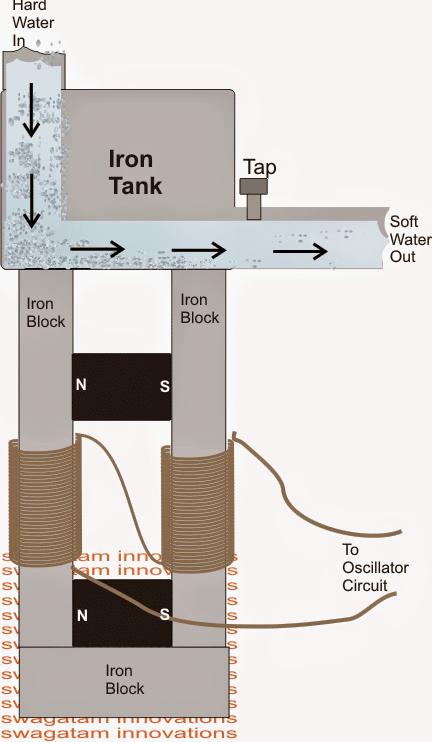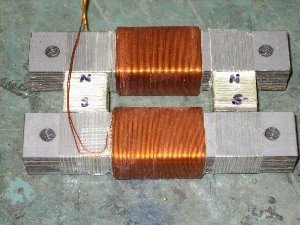In this post I have explained a circuit design which can be used for softening hard water and for descaling it into soft water. The idea was requested by Dimple rathode.
Technical Specifications
My name is Dimple and i am an electronic hobbyist. I look up to your blog whenever i have any doubt regarding any circuit and it helps me a lot. Thank you very much for your blog.
Recently a farmer who is also an electronic enthusiast came to me to build an electronic water softener which he came across while browsing. He wants to install it in his farm to reduce the scale formation inside the pipes.
I request you to send me the schematic of an electronic water softener which can be used for agricultural purpose. I am sure you will not disappoint me sir.Please....
Thanks and regards
The Design
Water available through natural resources may contain many dissolved minerals such as sodium, magnesium, calcium etc. and are termed as hard water. Due to the presence of these minerals especially calcium, hard water create problems and become unfriendly for our home use, our everyday domestic applications such as washings clothes, bathing, etc.
Such waters need to be converted from hard to soft by using certain forced external methods. There are many different methods which have been found to be effective for making hard water into soft water, like by the way of distillation, by applying reverse osmosis, by using other chemicals such as caustic soda, sodium etc.
Using Magnetic Field
There's another passive method for acquiring identical results, that's by using a magnetic field around the passage of the hard water through a pipe. Strong permanent magnets may be attached across the length of the pipe and hopefully positive results could be attained for the same.
The magnetic field affects the free flow of the dissolved calcium crystals and forces it to cling and stick with other crystals in the vicinity and form larger crystals which finally stick around the inner walls of the pipe due to the presence of the strong magnetic field. The result being a cleaner water free from calcium and much friendlier for our everyday use in our bathrooms.
However according to many researchers, instead of using passive magnets if the magnetic field is oscillated produces a greater influence on the Calcium crystals causing the crystallization process to activate quicker and at an much efficient rate.
The following circuit arrangement which incorporates a parallel path magnetization principle can be effectively used as a water softener when implemented as per the shown instructions:
Circuit Diagram Layout

In the above water softener circuit we can see a small tank or metallic container used as an intermediate water storage area through which the hard water is allowed to pass.
This container is made up of a ferromagnetic material such as iron.
This iron container is attached with a special electromagnetic arrangement consisting of a U shaped iron device configured with a couple permanent magnets and couple of wound inductors as shown in the image above.
Applying Parallel Path Concept
This electromagnetic device is based on parallel path concept for extracting an enhanced magnitude of magnetic field from a small amount of current input and in an oscillating manner.

The exact detail of the electromagnet may be witnessed in the above image, and the entire principle may be studied in this parallel path technology article
The coils or the shown inductors are connected with an alternating frequency generator circuit which may be implemented using any suitable oscillator design such a IC 555 or an transistor AMV circuit.
The inductor winding data is not crucial, any thin super enameled wire may used, around 500 turns on each side will be enough.
The tank being a ferromagnetic material gets completely magnetized generating a strong influence on the water content.
The calcium content which may be in the hard water get significantly influenced and start attaching among themselves.
The procedure allows the unwanted calcium to clog on the tank walls and the soft clean water is allowed to pass through outlet across the other end of the container.
Hello, do u have a circuit diagram for yarna or ispring water softner. ? Can we wind the coil on the pipe directly instead of winding on iron and creating a electro magnet.. electric water softners sold in us and uk just ask to wind some wire on the pipe. Thanks
Yes, that’s correct, you can wind a few turns on the metal pipe itself for implementing the water softner function.
However, using an electromagnet can produce better and more effective results.
An insulated coil around a plastic pipe is enough to send an RF frequency., for electronic descaling, is it not? There is no need to use iron to magnetize.
Iron might induce stronger magnetic fields enabling stronger descaling?
Good morning sir.
Can you share design of magnetic softner , in which no need of copper coiling , and no need of electricity.
Regards
Vikas Sharma
Delhi India
Hi Vikas,
I am sorry, I do not have the necessary information to design a magnetic softner with the mentioned specifications. If I happen to get it I will surely let you know.
No need to say sorry sir , it’s ok .
Regards
If you use a iron water tank, wont it corrode in the soft water ?
I suppose it can be coated with epoxy or teflon, but not stainless as it might short the flux..
Yes you are right, thanks for your feedback.
Thanks for the valuable info . Crystallization phenomena utilized in your concept is so effective way for the calcium ions depositions by the magnetic and electric field applications techniques . According to physical chemical phenomena , say , cyclotron frequency , the CF value for the calcium is 34 and hence we need nearly 50 Hz oscillator sweep frequency modulated with 10 kHz carrier can give superficial effect of accumulation of base metal ions salts on ferrous water drum materials with good softening effect , very low ppm. we also have an to idea forcefully implement it our water projects . We want to implement the SOFT WATER water project as our public social service through our Trust located AT KADAMALAIKUNDU , THENI District since from this year onward. Thanks
Thank you for the clarification and the info, It is much appreciated.
We Wish you all the best for the project!
I had raised this doubt as i remember to have read an article in ekector magazine if I am correct that it was mentioned as only a few Hz . I have come across some commercial water softener fittings which use 2 or more ring type permanent magnets along the water flow path. Also does the set up require a periodic clea up or descaling?
OK, then it could be right, I am not too sure about the exact frequency for generating a perfect soft water outcome…if elektor electronics says a few Hz, it might be correct.
yes a correctly working model will require a regular cleaning of the tank or the concerned pipes.
Dear Swagatam this article was quite informative thank you for the same . I would like to know if the pulsating oscillator ‘s frequency range or if fixed frequency ,what is its value. Also in related article on fliynn’s motor is the rotor magnetised ,if so the pole distribution details if you can kinly provide ,thanks and keep up the good work. GOD blessyou.
Dear S. krishnamurthy, the frequency of the oscillator is not critical, you can perhaps use a 50 Hz frequency as it would be most suitable for the laminated iron core. In Flynn’s motor the rotor is not magnetized, however it should made up of a ferromagnetic material such as iron, to be precise laminated iron.
Can i use battery in this project?
yes you can
Hi sir, may i ask if i can use different magnet instead of a permanent magnet? Thanks you ?
Hi Mercy, you can use any type of magnet, as long as it's a magnet…..
Not yet Kevin, I have only tried to present my assumption regarding the concept that greater force would result in more effective softening of water through the described process…..
Dear bro i need a simple water softener circuit diagram for home Water tank.Could u help me for this?
Dear bro, I have one design posted in this site, but I have not tested it.
https://www.homemade-circuits.com/2014/12/water-softener-circuit-explained.html
I WONDERFULL FROM YOU
ALTHOU THANK YOU